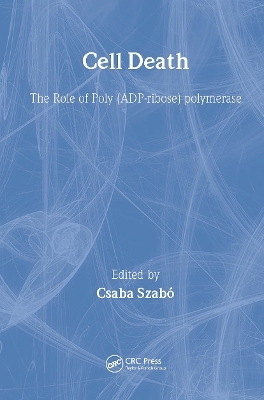
Cell Death
The Role of PARP
Seiten
2000
Crc Press Inc (Verlag)
978-0-8493-2267-9 (ISBN)
Crc Press Inc (Verlag)
978-0-8493-2267-9 (ISBN)
Featuring contributions from researchers in the diverse fields of neuroinjury, myocardial injury, diabetes, shock, and inflammation, this text examines the status of the field of poly (ADP-ribose) polymerase (PARP) and cell death. It also explores PARP and apoptosis, PARP and DNA repair, as well as PARP and regulation of gene expression.
Poly (ADP-ribose) polymerase (PARP), also termed poly (ADP-ribose) synthetase (PARS) is a nuclear enzyme with a wide range of functions, including regulation of DNA repair, cell differentiation, and gene expression. More than a decade after the identification of PARP-like enzymatic activities in mammalian cells, a novel role was proposed for this enzyme, mediating a suicidal mechanism triggered by DNA strand breakage. This hypothesis has since become a controversial centerpiece of the PARP field, with many experimental systems both confirming and extending the PARP suicide theory.
Theoretical and practical implications of the PARP suicide pathway were not extensively exploited until the 1990s. Researchers, for example, discovered a variety of findings; among them, that nitric oxide can activate a pathway leading to cell death (Neuronal cell death and pancreatic cell death), and that peroxynitrite, a reactive oxidant species produced from the reaction of nitric oxide and superoxide free radicals, is an endogenously produced trigger of DNA single strand breakage and PARP activation.
Featuring contributions from researchers in the diverse fields of neuroinjury, myocardial injury, diabetes, shock, and inflammation, this text examines the current status of the field of PARP and cell death. Cell Death: The Role of PARP also explores PARP and apoptosis, PARP and DNA repair, as well as PARP and regulation of gene expression. Separate chapters focus on developments in the areas of pharmacological inhibition of PARP and on novel ways of measuring PARP activation. Furthermore, the emerging field of PARP isoforms is addressed.
While tremendous progress has been made in the area of PARP and cell death, many controversies need to be clarified, and recent discoveries and observations require further development. Cell Death: The Role of PARP not only presents a state-of-the-art overview of the field, but serves as a catalyst for further research in this area.
Poly (ADP-ribose) polymerase (PARP), also termed poly (ADP-ribose) synthetase (PARS) is a nuclear enzyme with a wide range of functions, including regulation of DNA repair, cell differentiation, and gene expression. More than a decade after the identification of PARP-like enzymatic activities in mammalian cells, a novel role was proposed for this enzyme, mediating a suicidal mechanism triggered by DNA strand breakage. This hypothesis has since become a controversial centerpiece of the PARP field, with many experimental systems both confirming and extending the PARP suicide theory.
Theoretical and practical implications of the PARP suicide pathway were not extensively exploited until the 1990s. Researchers, for example, discovered a variety of findings; among them, that nitric oxide can activate a pathway leading to cell death (Neuronal cell death and pancreatic cell death), and that peroxynitrite, a reactive oxidant species produced from the reaction of nitric oxide and superoxide free radicals, is an endogenously produced trigger of DNA single strand breakage and PARP activation.
Featuring contributions from researchers in the diverse fields of neuroinjury, myocardial injury, diabetes, shock, and inflammation, this text examines the current status of the field of PARP and cell death. Cell Death: The Role of PARP also explores PARP and apoptosis, PARP and DNA repair, as well as PARP and regulation of gene expression. Separate chapters focus on developments in the areas of pharmacological inhibition of PARP and on novel ways of measuring PARP activation. Furthermore, the emerging field of PARP isoforms is addressed.
While tremendous progress has been made in the area of PARP and cell death, many controversies need to be clarified, and recent discoveries and observations require further development. Cell Death: The Role of PARP not only presents a state-of-the-art overview of the field, but serves as a catalyst for further research in this area.
Csaba Szabo
Preface. Cell Death by Energy Depletion: Discovery and Early Developments. Oxidative Stress and PARS Activation. Nitrosative Stress and PARS Acitvation. PARS in Regulating Cell Necrosis and Apoptosis. PARS in Mediating Neuronal Injury in Stroke and Neurotrauma. PARS in Mediating Chronic Neurodegeneration. PARS Activation and Myocardial Reperfusion Injury. Role of PARS Activation in the Pathophysiology of Endotoxic and Hemorrhagic Shock. Role of PARS Activation in Diabetes. PARS Activation and Arthritas. PARS Activation and Inflammatory Bowel Disease. PARS in Regulating Macrophage Activation and Gene Expression. Pharmacological Inhibitors of PARS.
| Erscheint lt. Verlag | 22.6.2000 |
|---|---|
| Reihe/Serie | Handbooks in Pharmacology and Toxicology |
| Zusatzinfo | 12 Tables, black and white; 20 Halftones, black and white |
| Verlagsort | Bosa Roca |
| Sprache | englisch |
| Maße | 156 x 234 mm |
| Gewicht | 668 g |
| Themenwelt | Medizin / Pharmazie ► Medizinische Fachgebiete ► Pharmakologie / Pharmakotherapie |
| Naturwissenschaften ► Biologie ► Biochemie | |
| Naturwissenschaften ► Biologie ► Zellbiologie | |
| ISBN-10 | 0-8493-2267-7 / 0849322677 |
| ISBN-13 | 978-0-8493-2267-9 / 9780849322679 |
| Zustand | Neuware |
| Haben Sie eine Frage zum Produkt? |
Mehr entdecken
aus dem Bereich
aus dem Bereich
Arzneimittelverzeichnis für Deutschland (einschließlich …
Buch | Hardcover (2024)
Rote Liste Service GmbH (Verlag)
109,00 €


